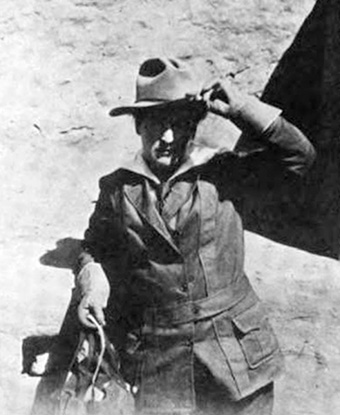Last updated: February 20, 2025
Person
Willa Cather

From "The Bookman" (December 1915). Public domain.
Wilella Sibert Cather was born in Virginia on December 7, 1873. She was the first of seven children of Mr. and Mrs. Charles Cather. Her life took her across the country, and she would become one of the premiere American authors of the 1900s.
When she was nine, Willa's father decided to move the family to the Nebraskan prairie. He was following his parents who had already migrated to Nebraska to homestead. Upon arriving, the Cathers settled on her grandparent's 160-acre homestead just outside the town of Red Cloud, Nebraska, which had a population of about 1,000 at the time.
After moving to Nebraska, Willa Cather struggled to adapt to her new home. The move traded the lush forests and rolling hills of northern Virginia for the brown, almost treeless flatness of the central plains. Her childhood experiences with this landscape and immigrant families crossing it profoundly affected Willa.
Like many families, the Cathers found homesteading to be a difficult and unrewarding life. Her parents left the homestead and moved into the town of Red Cloud. There, Willa worked delivering mail on horseback to many of the remote farms located outside the town.
Immigrants and landscapes would become the chief characters of Cather’s novels. As a child, she didn’t want to be a writer at all. She once stated, “The fact that I was a girl never damaged my ambitions to be a pope or an emperor.” Indeed, she had early interests in science and medicine, sometimes signing her name as Dr. William Cather, M.D. When she graduated high school and went to college, Willa enrolled to study medicine.
From Red Cloud she went on to the University of Nebraska. Not long after Cather began school at the university one of her teachers submitted a sample of her writing to the local newspaper. When the piece was published, Cather said the effect of seeing her name in print was hypnotic. Her focus changed from science and medicine to writing and editing. She took positions as editor, author, and critic for three different newspapers and wrote short stories―all at the same time―before she had even graduated from the university.
She graduated in 1894 and soon moved to Pittsburgh, Pennsylvania, where she was a teacher and journalist. In 1906, Willa Cather moved to New York City to be an associate editor at McClure's magazine. It was there that she also began to write her great novels, many of which were set on the Nebraska prairie she had so loved as a youth.
Over time, Cather would create 12 novels, numerous essays, four collections of short stories, three non-fiction titles, and one volume of poems. In 1913, she began working on what she called her Prairie Trilogy, reviving her childhood memories of Nebraska. The three books of the trilogy were O Pioneers!, The Song of the Lark, and My Àntonia.
Cather had a special affection for places now preserved in national parks and public lands. In 1912, a trip to visit her brother Douglass in Winslow, Arizona, brought her to the Grand Canyon, then part of the Kaibab National Forest. A smaller canyon in the Coconino National Forest east of Flagstaff would be renamed Panther Canyon in Cather’s 1914 novel The Song of the Lark. That canyon and its cliff dwellings are preserved today in Walnut Canyon National Monument. And in 1915, Willa and her beloved Edith would be some of the first visitors to Mesa Verde National Park in Colorado.
Cather’s career was inspired by women she was close to. Beginning in 1901 she lived and traveled abroad with Isabelle McClung. Their relationship was deeply emotional, and McClung encouraged Cather to write creatively. When McClung died in 1938, Cather said that she had written all her books for Isabelle. Cather also had a lifelong, intimate companionship with Edith Lewis, who helped edit her novels. The two met first in 1903 and shared an apartment in Greenwich Village, New York, from 1912 to 1927. In 1925 they built a home together on an island off the Maine coast, and by 1933 they moved again to a small apartment in New York City.
Though Cather never used the word “lesbian” to describe herself―the word didn’t become commonly used until after Cather’s death―she called it “manifestly unfair that feminine friendships” were rejected by society in her time. A sample from her letters to Edith describes her as “my darling.” Cather’s relationships, in turn, have inspired LGB audiences. Willa and Edith are buried together at the Old Burying Ground in Jaffrey, New Hampshire.
By the time she died in 1947, Willa Cather was one of the most well known and critically acclaimed novelists of the 20th century. Her life and work have been honored by the National Women’s Hall of Fame, the Nebraska Hall of Fame, Virginia Women in History, the New York Writers’ Hall of Fame, the National Cowboy Museum and Hall of Fame, the U.S. Postal Service, and the U.S. Mint. She also won a Pulitzer Prize for her 1922 World War I novel One of Ours. She was always quick to attribute her success to her formative years on the Nebraska prairie as the daughter of a struggling homesteader.
Willa Cather was a groundbreaking author. Her work not only demonstrates literary supremacy but shows how the people and places we encounter in our lives can inspire us to accomplish greatness and leave behind a legacy that will encourage future generations.
